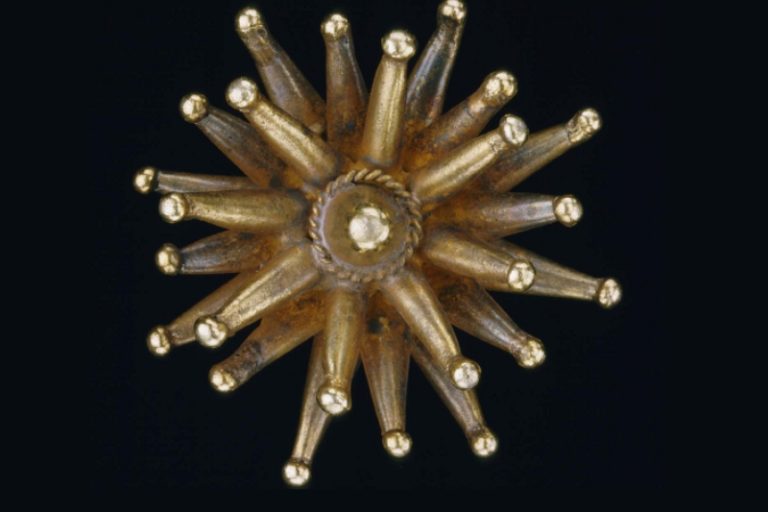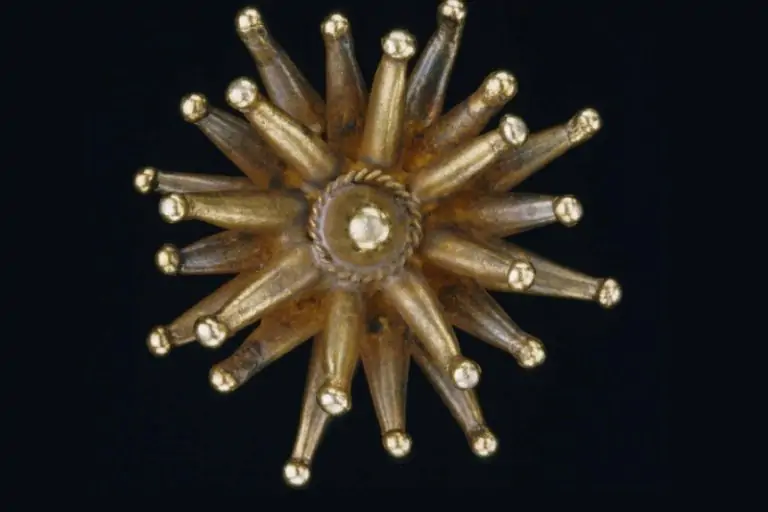

at the museum of fine arts boston akan gold shines
British ambassador Thomas Bowdich was one of the first Europeans to explore Africa’s Gold Coast. In 1817, Bowdich was shocked to see a gold-jeweled chieftain in Kumasi, Ghana. He stated, “One wrist is so heavily laden with gold that it is supported on the head of a small boy.”
Seeing Mr. Bowdich’s gold finery will change your idea of serious bling from pinkie rings to old-school gold chains. “West African Gold: Akan Regalia from the Glassell Collection” shows 130 cast, embossed, or gold-leafed adornments—some old, some new—and samples of hand-woven kente cloth, another prized Ghanaian art form, at the Museum of Fine Arts, Boston, until March 26, 2006. Last year, the Museum of Fine Arts, Houston, had Akan gold on display. On May 17–November 26, 2006, the Smithsonian’s National Museum of African Art will host the show.
“There’s a very elaborate tradition of chieftaincy or kingship in Ghana that’s still thriving,” describes the exhibition’s catalog author, art historian Doran H. Ross. In lively public festivals, Akan kings and their retinues have paraded with gold necklaces, rings, bracelets, amulets, even gilded muskets, and umbrella finials for centuries. Ross, a 1974 Akan festival veteran, believes regalia may be more lavish than ever.
Like New Orleans’ Mardi Gras, Akan processions aren’t slow marches. According to British historian Thomas McCaskie, they have “dense masses of people, intense noise—drumming, firing, cheering, singing, yelling, crying, debating—and a seemingly chaotic, highly fragmented, and relentlessly sustained assault on all the human senses.” In a 40,000-seat sports arena, thousands can attend a durbar.
Historically, Akan culture has valued gold. While Portuguese traders docked along Ghana’s rocky coast in the late 1400s, goldworking was already well-honed, and the interior was rich in resources. The Gold Coast, as a hub of the global gold trade, attracted European commercial ships carrying textiles, metalware, guns, and booze. For trading security, the Portuguese, Danish, Dutch, and English built coastal fortresses. These forts’ thick-walled rooms held chained captives waiting to be shipped to the Americas by the 18th century, a more lucrative export. The Akans’ largest ethnic group, the Asante, declared an internal “Kingdom of Gold” around 1700. In 1901, after many conflicts with the Asante, England conquered the Gold Coast.
Ghana, sovereign since 1957, has 125 Akan chiefdoms, or traditional republics, that preserve its precolonial culture. These states operate outside Ghana’s formal government, although their leaders have significant local power. For centuries, the ruling elites have commissioned the most ornate goldwork for display at new chief installation ceremonies. The village elders approve the appointment of rulers, which is usually done by a queen mother.
Previously, these valuables defined a community. In 1869, in a conflict with a rival state, a chiefdom lost warriors and regalia. The chiefdom declared triumph after finding the regalia the next day.
Chiefs currently wear crown-like, gold-trimmed headpieces, but their most regal adornment is golden shoes. “Sandals among the Akan serve as crowns among European royalty,” writes Ross. A large Akan event often has six or seven sandal-bearers at the front, each carrying the chief’s sandals. According to two German missionaries held hostage by the Akan in the early 1870s, buying a worn-out pair of royal sandals without authorization resulted in the miscreant’s beheading.
Inventive Akan goldwork can transmit boasts, insults, jokes, and proverbs. The Akan proverb says, “A fish out of water dies; a king without followers ceases to exist.” A parading chief who raises one hand and languidly rotates his wrist may be reminding his audience of this. The 1940 finial by Osei Bonsu on an ornate wooden staff depicts a man holding an egg, alluding to the proverb: “To be ruler is like holding an egg in the hand; if pressed too hard, it breaks; but if held tightly enough, it may slip and smash on the ground.” Both proverbs show, essentially, power’s limits.
Many of an Akan chief’s 8- to 12-carat gold accessories are considered state property. We melted gold during wartime to raise funds. A ruler who displays his gold jewelry proves that the communal treasure is intact. According to Ross, the treasury often expects a new chief to add regalia.
The demand for new pieces has kept Akan goldsmithing innovative. Europe introduced cannons and powder kegs as popular motifs. In the late 19th century, European influence made the lion, rare in Ghana, popular in Akan art. This was not an African lion, but rather a stylized version of the Rule-Britannia beast. Ross writes, “The Dutch, the Danish, and the British all had lions on their royal arms and ships.” By 1900, Akan Finery included exquisite gold reproductions of Victorian brooches and necklaces. Chiefs and other dignitaries wear gold bands that resemble luxury wristwatches.
Alfred C. Glassell, an oil-and-gas executive, donated over 900 items to the Houston Museum in 2001. Houston curator Frances Marzio, who organized the exhibition, says, “A community will sell off some of its old or damaged regalia and make new pieces.” “There’s no stigma to doing that, because most of these aren’t sacred.”
Akan chiefs are still influential, but they have more social status than political power. Ross says, “The chiefs I know are bankers and lawyers with college degrees, and their English is excellent.” Chiefs wearing gold replica wristwatches will likely glance at a regular watch on the other wrist to check the time.
Africa is taking big steps by entering the global green technology manufacturing market to stop being just a supplier of…
Two mobile telecom leaders, MTN Group and Airtel Africa, joined forces to create a new digital infrastructure system throughout African…
South African President Cyril Ramaphosa defended his nation against claims of white discrimination made by tech magnate Elon Musk. After…
Hilton launched Signia by Hilton for its first appearance in Egypt and Africa through its hotel expansions. These hotels at…
UNICEF reported that, nearly 2900 people died of cholera across Eastern and Southern African countries while children suffer most greatly…
Enza, based in the United Arab Emirates, obtained $6.75 million in initial investment funding from Algebra Ventures and Quona Capital.…
This website uses cookies.